Do you check your professional inbox after work hours in your free time?
Do you sometimes sneak a peek at your work phone during a vacation to see if there is any news?
If your answer to either (or both) of these questions is “Yes”, maybe you have trouble setting work boundaries.
If you’re working from home, these challenges may become even greater.
After all, when your morning commute consists of going from your bed to your desk in your slippers, you slowly lose the ability to distinguish between work and life.
If you recognize yourself in these problems, keep on reading.
In this blog post, we will define work boundaries, consider their types, and see how they relate to a healthy work-life balance.
We will also provide you with some tips that will help you set clearer work boundaries — no matter whether you’re working in an office or remotely.

Table of Contents
What are work boundaries and how do they relate to a healthy work-life balance?
Work boundaries are the rules we implement for ourselves, that give us a framework in which we work and spend time with our friends and family. They help us distinguish between our work hours and private life.
After all, work boundaries are a means to achieving a healthy work-life balance — a phrase and concept we have the Women’s Liberation Movement of the 1980s to thank for.
Back in the 80s, to make it easier for women in the workforce, flexible working schedules and maternity leave were introduced.
In the beginning, this concept concerned only women, who were expected to hold down their jobs, continue to be primary caretakers of the children, and perform domestic work.
Later, this concept was used to address the problems of both working men and women.
So, today, work-life balance is the degree to which an individual prioritizes their personal and professional responsibilities in their life and the presence of work-related activities in their home.
This kind of balance is especially hard to achieve when working from home.
What once was almost solely reserved for IT companies and a few odd freelance jobs, has become “the future of work” since the beginning of the COVID-19 pandemic.
Luckily, the work-from-home arrangement seems to work for a lot of people — according to the Remote work statistics 2022, a staggering 97% of respondents said that they would recommend remote work to others.
Thanks to technological advances, it is now possible for workers to stay in touch with their colleagues 24/7, which can significantly upset the work-life balance.
Luckily, there are several types of work boundaries you can impose to establish a better work-life balance.
Types of work boundaries
When talking about work boundaries, it helps to categorize them so that we can understand them more clearly.
There are 4 subcategories of work boundaries:
- Emotional boundaries — Boundaries concerning your feelings (e.g. how you handle colleagues’ feelings).
- Time boundaries — Boundaries that deal with how you handle other people’s requests and manage your time (e.g. not answering your emails outside your work hours).
- Physical boundaries — Boundaries that have to do with how you engage with your colleagues and establish a safe work environment (e.g. shaking someone’s hand instead of hugging them).
- Mental boundaries — Boundaries that help you disconnect from your work (e.g. family time, relaxation, paid time off, etc.).
Now that we’ve seen what types of boundaries at work there are, let’s consider why they’re important.
The importance of work boundaries
To better understand work-life balance and work boundaries, let’s look at the benefits these boundaries bring.
Work boundaries help prevent burnout
Undefined work boundaries lead to physical and mental exhaustion and, eventually, to burnout.
Burnout is an occupational phenomenon recognized by the World Health Organization, where it’s described as “a syndrome conceptualized as resulting from chronic workplace stress that has not been successfully managed”.
Did you know that, according to the 2021 Global Burnout Study, “burnout makes people
2.6 times more likely to leave their current employer”?
The consequences of burnout are:
- Physical health issues (increased likelihood of heart disease, high blood pressure, type 2 diabetes, etc.),
- Mental health issues (depression, anger, irritability, anxiety, etc.),
- Personal consequences (alcohol or substance abuse, isolation from friends and family), and
- Professional consequences (e.g. job dissatisfaction, inability to do the job well, etc.).
So, how do we prevent burnout?
Setting boundaries helps us deal with these issues and decreases levels of stress. By learning to say ‘No’ and identifying our priorities we nip the burnout in the bud. We don’t allow ourselves to work overtime and exhaust ourselves.
However, we should be extra careful about choosing the right time to do that.
A licensed psychotherapist Joyce Marter at Psychology Today claims that the right time to do that is as soon as you realize you’re on your way to burnout.
She advises us to “use assertive communication with supervisors to set boundaries with workload and expectations”.
Work boundaries ensure we fulfill our basic needs for a good life
Work boundaries are essential for the fulfillment of our basic needs.
We will consider these needs in light of Maslow’s theory of human motivation.
Namely, according to Maslow, people have needs that need to be met in order.
Firstly, our physiological needs have to be fulfilled, such as food and water.
Furthermore, we need to feel safe, to feel loved, and belong to a group.
Only then can we move on to the issues of self-esteem, and cognitive and aesthetic needs.
After that, comes the highest level — self-actualization.
Now that we’ve categorized our needs, it is clear that all the basic needs depend on our work. By earning money, we can buy food and provide ourselves with a roof over our heads. Safety comes from regular income.
At the workplace, we also belong to a group, and our self-esteem stems partly from the success we achieve at work.
So, the lower levels of needs in the hierarchy of needs are largely met through our professional activities.
The higher levels in this hierarchy belong to needs that cannot be satisfied through work — this is where our lifestyle and having free time come forward.
Again, work boundaries help us satisfy these needs — by giving us a healthy work-life balance and time, to use as we please. For instance, if we leave enough time in the day for activities that are not related to work, we can go to that new art gallery or the movies with our friends.
Work boundaries help us stay focused at work
When we set work boundaries, we give ourselves a set time frame during which we can get the work done more attentively.
Bear in mind, multitasking is our enemy.
When we try to juggle work and private life, we usually end up in a bigger mess than we were before.
However, setting clear boundaries at work helps us concentrate on our work during work hours. Since we know we have a limited time to do the daily tasks, we tend to focus better and do a better job overall.
Apart from that, we also achieve a better work-life balance.
Consequently, when our improved focus helps us finish work on time, we have more free time to pursue our hobbies and hang out with friends and family. This all improves the quality of our life.
—
Now that we’ve seen why setting boundaries at work is important, let’s consider some of the ways that can help you set them.
Pumble makes setting work-life boundaries easy
8 Tips on creating healthy work boundaries
As we’ve seen in the previous paragraphs, work boundaries are important for our overall health and our productivity.
Get ready for some tips that will help you set clear boundaries (and stick with them)!
Tip #1: Identify your priorities
Remember Maslow’s theory? Although our basic needs are dependent on our work, we should strive not to lose our personal life from sight.
The first thing you need to do before setting boundaries at work is to make a list of your priorities, so you know how to distribute your time and energy.
If you want more time for your loved ones or your hobby, keep that in mind while planning your work week.
This goes for your work also — set your priorities.
Do you want to work towards a promotion or finish all those minor tasks that keep on piling up?
Whatever your goals are, set them straight and prioritize your tasks.
Tip #2: Communicate upfront clearly and concisely
Now that you’ve identified your priorities, it’s time to communicate them to your coworkers.
This can be as simple as notifying your colleagues about the fact that you don’t answer your emails after work hours, as in an example from Pumble below.
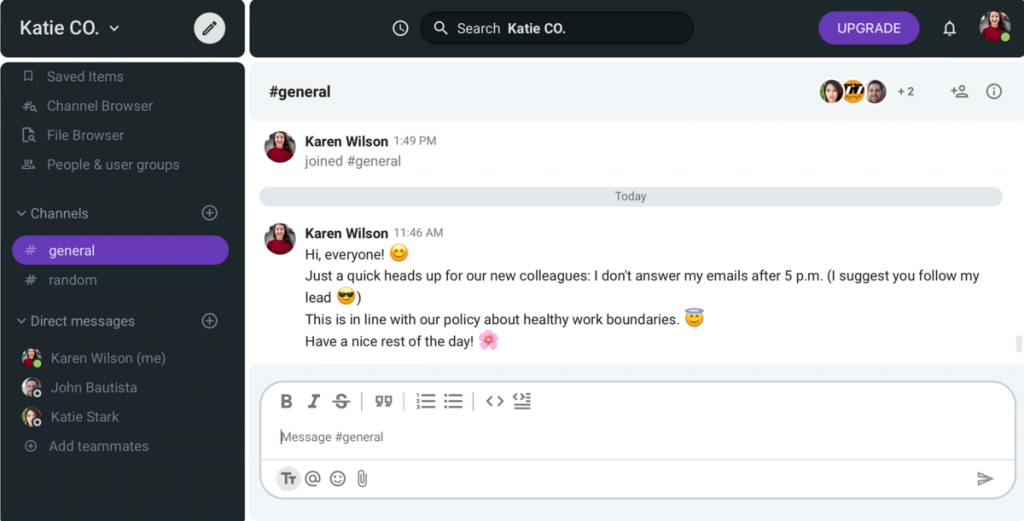
Karen Wilson, a developer in a large company, is letting her new colleagues know about the company’s policy concerning work boundaries. She is using her own example, to show them that their free time is valuable and should not be wasted on answering work-related emails outside of work hours.
If you want your colleagues to respect your boundaries, you have to be clear about them. Don’t expect your coworkers to read your mind.
Establish healthy work-life boundaries with Pumble
Tip #3: Learn to say ‘No’
OK, you’ve clearly communicated your boundaries to your colleagues and now your work is done, right?
Wrong!
There’s no use in setting boundaries if you’re not prepared to defend them.
Now comes the hard part — learning to say ‘No’.
Saying this tiny word is a powerful skill some people find difficult to master.
But, think of the word ‘No’ as your bodyguard that saves you from burnout and overworking.
In an article on burnout, career change coach Lisa Lewis Miller says that if you’re saying ‘Yes’ to too many responsibilities, you might be suffering from “leaky boundaries”.
The solution to patching up these leaks — a two-letter word. (You guessed it — ‘No!’)
In the example below, Christina is saying ‘No’ to going to a conference she finds interesting because she’s swamped with previous arrangements. She’s successfully guarding her boundaries.
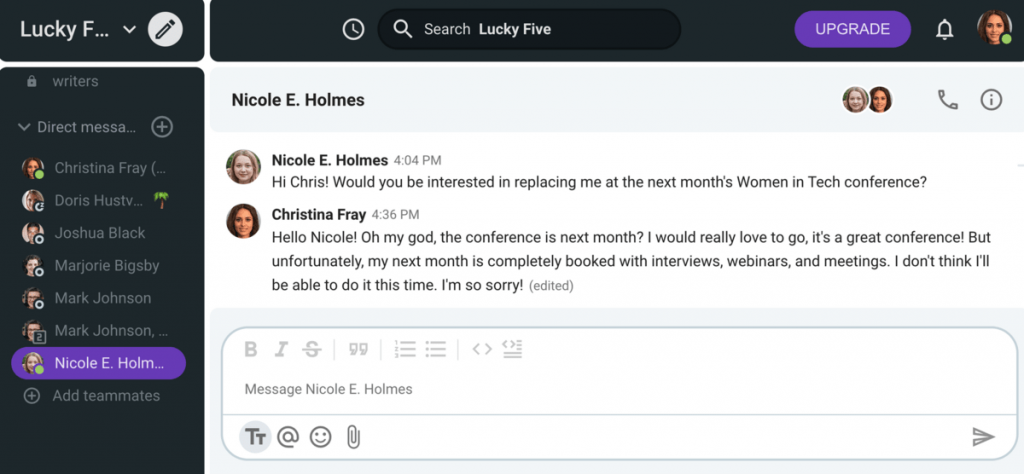
Tip #4: Take time off
Another concrete way to set work boundaries is to use your PTO. After all, you earned it.
Don’t fall prey to modern-day mantras, such as “Stop whining, start hustling”.
There’s nothing admirable about not using your vacation days — they exist for a reason.
The reason is to take a break from work, replenish your energy, spend time with family and friends, and come back refreshed and full of ideas.
Don’t forget to set your status in Pumble, so you don’t get disturbed during your vacay!
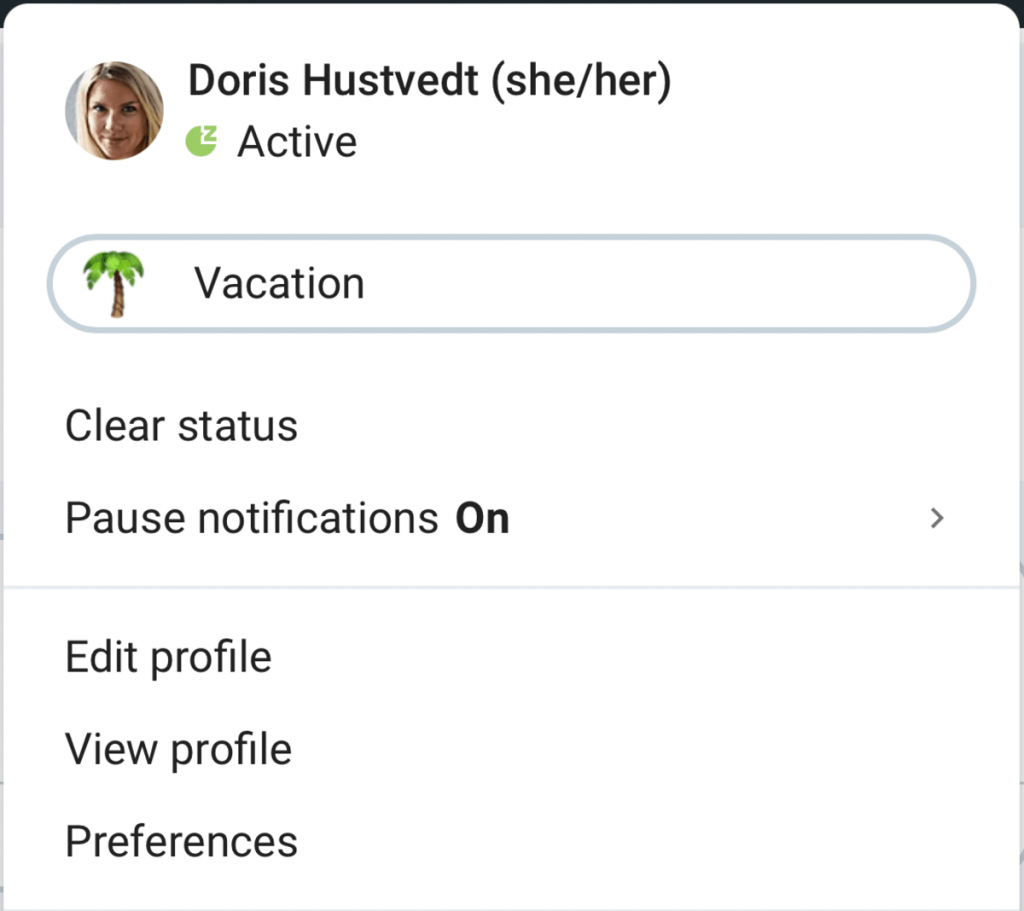
Tip #5: Create built-in breaks
Have you ever forgotten to have lunch because you were preoccupied with your workload?
Or, maybe you gobbled up a sandwich while sitting at your desk and resolving an urgent matter?
Mind you, if you did those things, you violated your own boundaries — you deserve to eat your meal in peace, at the table, not staring at that spreadsheet while you chew your hamburger.
To avoid the above-mentioned situations, mark your lunch break on your calendar and set a reminder.
That way, your colleagues will know when to leave you alone and you might never ever skip your meals at work again!

Tip #6: Develop a system
A useful way to deal with your workload, while respecting your (and other people’s) boundaries, is to develop a system that works for you.
What’s the best way to do that?
Let’s hear it from the experts!
If you want to get things done (and not lose yourself in the process), just listen to what David Allen, a productivity expert and author of Getting Things Done, has to say.
Allen suggests you sort through your to-do list in one of the following ways:
- Do it,
- Defer it,
- Delegate it,
- Drop it.
This 4D method allows you to tackle each item on your list just once and move on to the next one.
It prevents you from getting stuck on a task that is impossible for you, but a piece of cake for your colleague.
Tip #7: Be ready for boundary breaches and bring up the violation right away
Unfortunately, no matter how clearly you set them, boundaries are bound to get broken.
When that happens, be sure to say something to make the person who breached them aware of their transgression.
It is important to do that as soon as possible after a violation.
Don’t forget to be empathic when you tell people how it bothers you when your boundaries aren’t respected.
Maybe the person who breached the boundary wasn’t aware they were crossing the line, so they would appreciate your input. It would also help them avoid the same mistake in the future.
In the Pumble example below, after she got emails about the latest project from her colleagues while she was on vacation, Emma Federici is politely reminding her coworkers that she won’t be answering work-related emails and messages in the next two weeks.
Furthermore, she’s instructing her colleagues to reach out to Rose Tennant, who’ll help them in Emma’s absence.
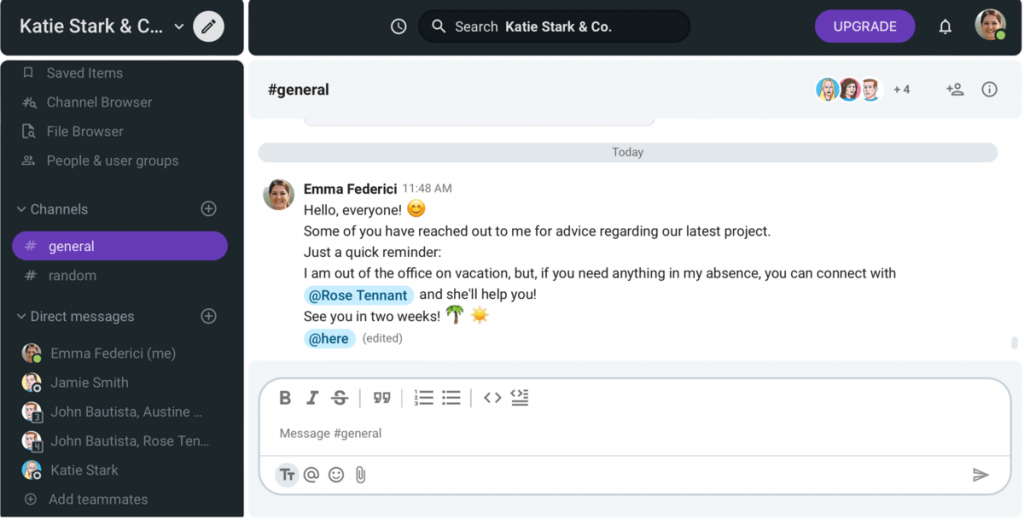
Tip #8: Set your work boundaries when working remotely too
Since remote work is here to stay, it’s time we deal with the ways to distinguish between work and life and to make these boundaries at least a bit clearer.
The key word here is balance.
Research has shown that the lack of a healthy work-life balance can result in a variety of stress factors, including:
- Fatigue,
- Discouragement,
- Heart disease,
- High blood pressure,
- Depression,
- Unhappiness,
- Anxiety, etc.
Add to all that the fact that remote workers face some common challenges such as stress, loneliness, and anxiety.
Remote work itself may lead to feelings of isolation and can reduce their productivity and mental well-being.
However, 3 simple steps can help you set work boundaries as a remote worker.
Step #1: Create a designated workspace
When working remotely, it is essential you find a workspace in which you feel both comfortable and productive.
Your designated workspace need not be a whole room if you’re tight with space.
A corner with a desk, a chair, and a cabinet for storing work papers are more than enough.
Add to that a plant, to cheer you up, and a motivational picture for you to gaze at when you’re feeling tired, and the boundary is set.
Now you know — your work time ends when you leave your desk.
Maybe you’ll be tempted to go back to it, but resist the urge.
Step #2: Limit your work hours
When speaking of setting work boundaries, a limited work schedule is equally important.
First and foremost, set work hours. Yes, you do need structure, even when working remotely. Some tools can assist you in tracking your time spent working.
Take breaks every 90 minutes to avoid exhaustion, or try out the famous Pomodoro technique.
Equally important is to set your morning routine, which will help you get started with the workday.
Some high-performing people like to start their day with a workout. It helps them activate their minds, as well as bodies, and prepare for the day ahead.
Step #3: Set boundaries with the people you work and live with
Let’s start with setting professional boundaries with the people you work with.
In her research, Managing Work life in the Digital Age, Ellen Ernst Kossek argues that one of the main culprits of blurred work boundaries is the constant use of technology and social media.
Since we’ve established that the majority of remote work communication takes place via chat apps, it is best that you use a separate business messaging app, such as Pumble, for professional communication — so that you don’t have to be available to your colleagues all day.
Keep in mind that there is always a certain chat etiquette you should follow.
If you don’t want to be distracted during your busy hours, maybe the best solution for you is asynchronous communication.
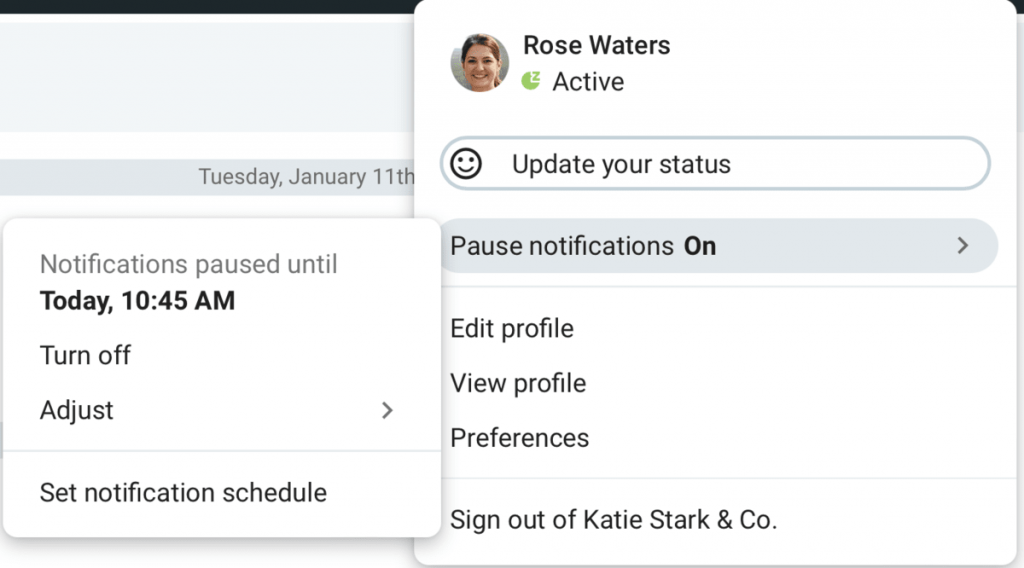
When speaking of setting boundaries with your friends and family, the situation may be even trickier.
Saying ‘No’ is hard (especially to your friends and family), but it is one of the crucial aspects of being assertive. Sometimes you’re afraid to say ‘No’ for that famous fear of missing out — but, keep in mind that experts on the topic, Vanessa M. Patrick and Henrik Hagtvedt, state that saying ‘No’ is essential for your well-being. In their research, they hypothesize and empirically demonstrate that even framing a refusal using “I don’t” as opposed to “I can’t” is more empowering.
In other words — yes, you can pick up your friend from the airport, but you don’t want to (or simply can’t) do that during work hours.
Create work-life boundaries with Pumble
As you have seen above, creating clear work-life boundaries brings multiple advantages.
One of the main preconditions for achieving work-life balance, as mentioned before, is to avoid being “constantly present” at work by clearly stating when you are at work, and when you aren’t. Thanks to Pumble, that is one click away.
The availability status, next to your name on Pumble, informs others in your team or organization about your status — whether you’re available, on a break or holiday, or in a meeting.
Another way Pumble can increase your work-life balance is by allowing you to spend less time in the office. Instead of commuting, you can simply arrange a video conference or audio call and discuss important matters with utmost security.

Let Pumble help you set boundaries in your life and prevent burnout!







